MGBBT0UBN: Case Study on Travelodge Hotel Business Organisation
VerifiedAdded on 2023/06/04
|9
|2128
|96
Case Study
AI Summary
This case study examines Hotel Travelodge, a private limited hotel chain, founded in 1973. The study analyzes its hierarchical organizational structure, detailing advantages such as a clear path for employees and department loyalty, and disadvantages like high costs and potential for poor communication. The business environment analysis employs SWOT and PESTEL frameworks to evaluate internal strengths and weaknesses, external opportunities and threats, and the impact of political, economic, social, technological, environmental, and legal factors. The SWOT analysis reveals strengths like a knowledgeable staff, but also weaknesses such as a lack of innovation. PESTEL analysis considers factors such as government regulations, economic fluctuations, customer behavior, technological advancements, environmental concerns, and legal compliance. The study concludes by emphasizing the importance of understanding both internal and external factors for effective business management and adaptation within the competitive hotel industry.
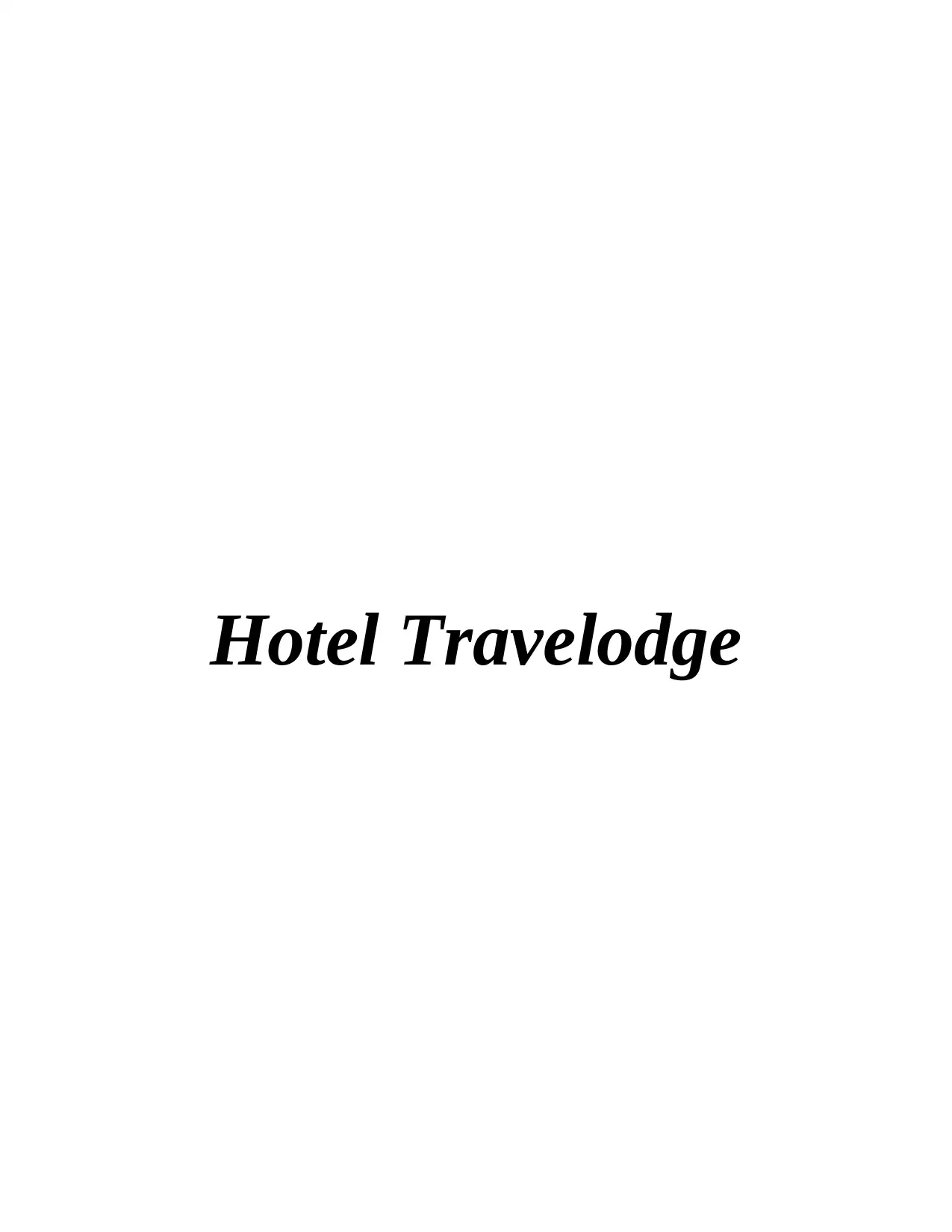
Hotel Travelodge
Paraphrase This Document
Need a fresh take? Get an instant paraphrase of this document with our AI Paraphraser
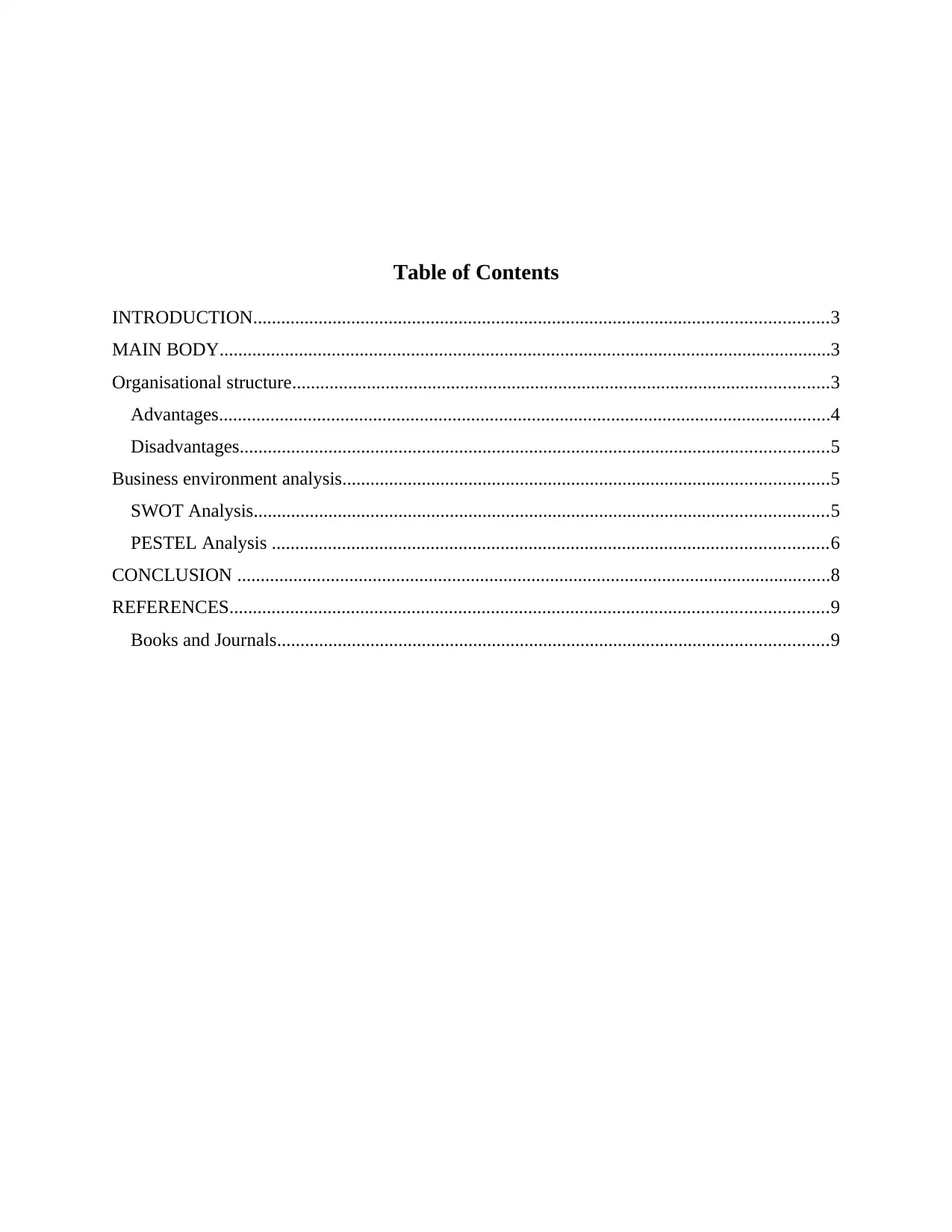
Table of Contents
INTRODUCTION...........................................................................................................................3
MAIN BODY...................................................................................................................................3
Organisational structure...................................................................................................................3
Advantages...................................................................................................................................4
Disadvantages..............................................................................................................................5
Business environment analysis........................................................................................................5
SWOT Analysis...........................................................................................................................5
PESTEL Analysis .......................................................................................................................6
CONCLUSION ...............................................................................................................................8
REFERENCES................................................................................................................................9
Books and Journals......................................................................................................................9
INTRODUCTION...........................................................................................................................3
MAIN BODY...................................................................................................................................3
Organisational structure...................................................................................................................3
Advantages...................................................................................................................................4
Disadvantages..............................................................................................................................5
Business environment analysis........................................................................................................5
SWOT Analysis...........................................................................................................................5
PESTEL Analysis .......................................................................................................................6
CONCLUSION ...............................................................................................................................8
REFERENCES................................................................................................................................9
Books and Journals......................................................................................................................9
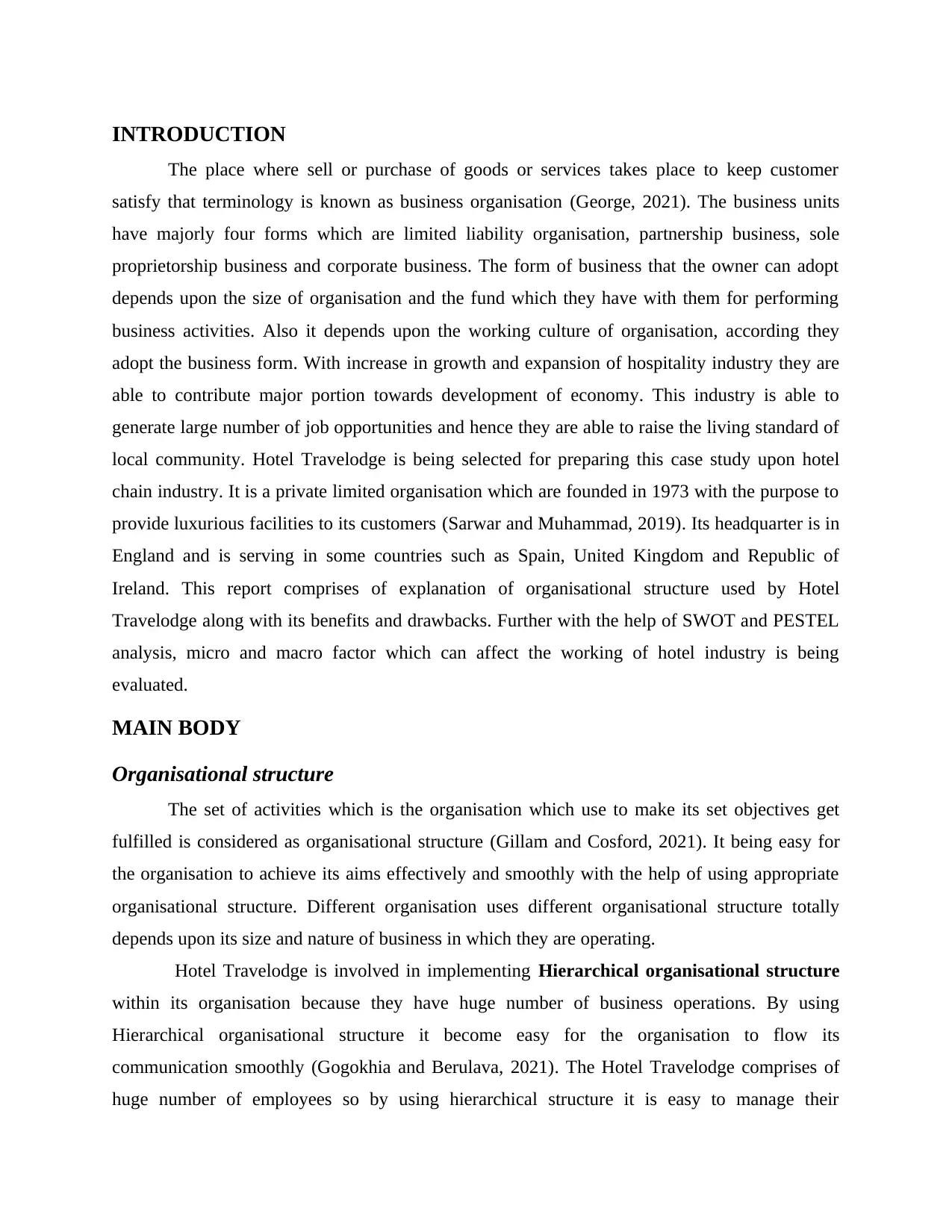
INTRODUCTION
The place where sell or purchase of goods or services takes place to keep customer
satisfy that terminology is known as business organisation (George, 2021). The business units
have majorly four forms which are limited liability organisation, partnership business, sole
proprietorship business and corporate business. The form of business that the owner can adopt
depends upon the size of organisation and the fund which they have with them for performing
business activities. Also it depends upon the working culture of organisation, according they
adopt the business form. With increase in growth and expansion of hospitality industry they are
able to contribute major portion towards development of economy. This industry is able to
generate large number of job opportunities and hence they are able to raise the living standard of
local community. Hotel Travelodge is being selected for preparing this case study upon hotel
chain industry. It is a private limited organisation which are founded in 1973 with the purpose to
provide luxurious facilities to its customers (Sarwar and Muhammad, 2019). Its headquarter is in
England and is serving in some countries such as Spain, United Kingdom and Republic of
Ireland. This report comprises of explanation of organisational structure used by Hotel
Travelodge along with its benefits and drawbacks. Further with the help of SWOT and PESTEL
analysis, micro and macro factor which can affect the working of hotel industry is being
evaluated.
MAIN BODY
Organisational structure
The set of activities which is the organisation which use to make its set objectives get
fulfilled is considered as organisational structure (Gillam and Cosford, 2021). It being easy for
the organisation to achieve its aims effectively and smoothly with the help of using appropriate
organisational structure. Different organisation uses different organisational structure totally
depends upon its size and nature of business in which they are operating.
Hotel Travelodge is involved in implementing Hierarchical organisational structure
within its organisation because they have huge number of business operations. By using
Hierarchical organisational structure it become easy for the organisation to flow its
communication smoothly (Gogokhia and Berulava, 2021). The Hotel Travelodge comprises of
huge number of employees so by using hierarchical structure it is easy to manage their
The place where sell or purchase of goods or services takes place to keep customer
satisfy that terminology is known as business organisation (George, 2021). The business units
have majorly four forms which are limited liability organisation, partnership business, sole
proprietorship business and corporate business. The form of business that the owner can adopt
depends upon the size of organisation and the fund which they have with them for performing
business activities. Also it depends upon the working culture of organisation, according they
adopt the business form. With increase in growth and expansion of hospitality industry they are
able to contribute major portion towards development of economy. This industry is able to
generate large number of job opportunities and hence they are able to raise the living standard of
local community. Hotel Travelodge is being selected for preparing this case study upon hotel
chain industry. It is a private limited organisation which are founded in 1973 with the purpose to
provide luxurious facilities to its customers (Sarwar and Muhammad, 2019). Its headquarter is in
England and is serving in some countries such as Spain, United Kingdom and Republic of
Ireland. This report comprises of explanation of organisational structure used by Hotel
Travelodge along with its benefits and drawbacks. Further with the help of SWOT and PESTEL
analysis, micro and macro factor which can affect the working of hotel industry is being
evaluated.
MAIN BODY
Organisational structure
The set of activities which is the organisation which use to make its set objectives get
fulfilled is considered as organisational structure (Gillam and Cosford, 2021). It being easy for
the organisation to achieve its aims effectively and smoothly with the help of using appropriate
organisational structure. Different organisation uses different organisational structure totally
depends upon its size and nature of business in which they are operating.
Hotel Travelodge is involved in implementing Hierarchical organisational structure
within its organisation because they have huge number of business operations. By using
Hierarchical organisational structure it become easy for the organisation to flow its
communication smoothly (Gogokhia and Berulava, 2021). The Hotel Travelodge comprises of
huge number of employees so by using hierarchical structure it is easy to manage their
⊘ This is a preview!⊘
Do you want full access?
Subscribe today to unlock all pages.

Trusted by 1+ million students worldwide
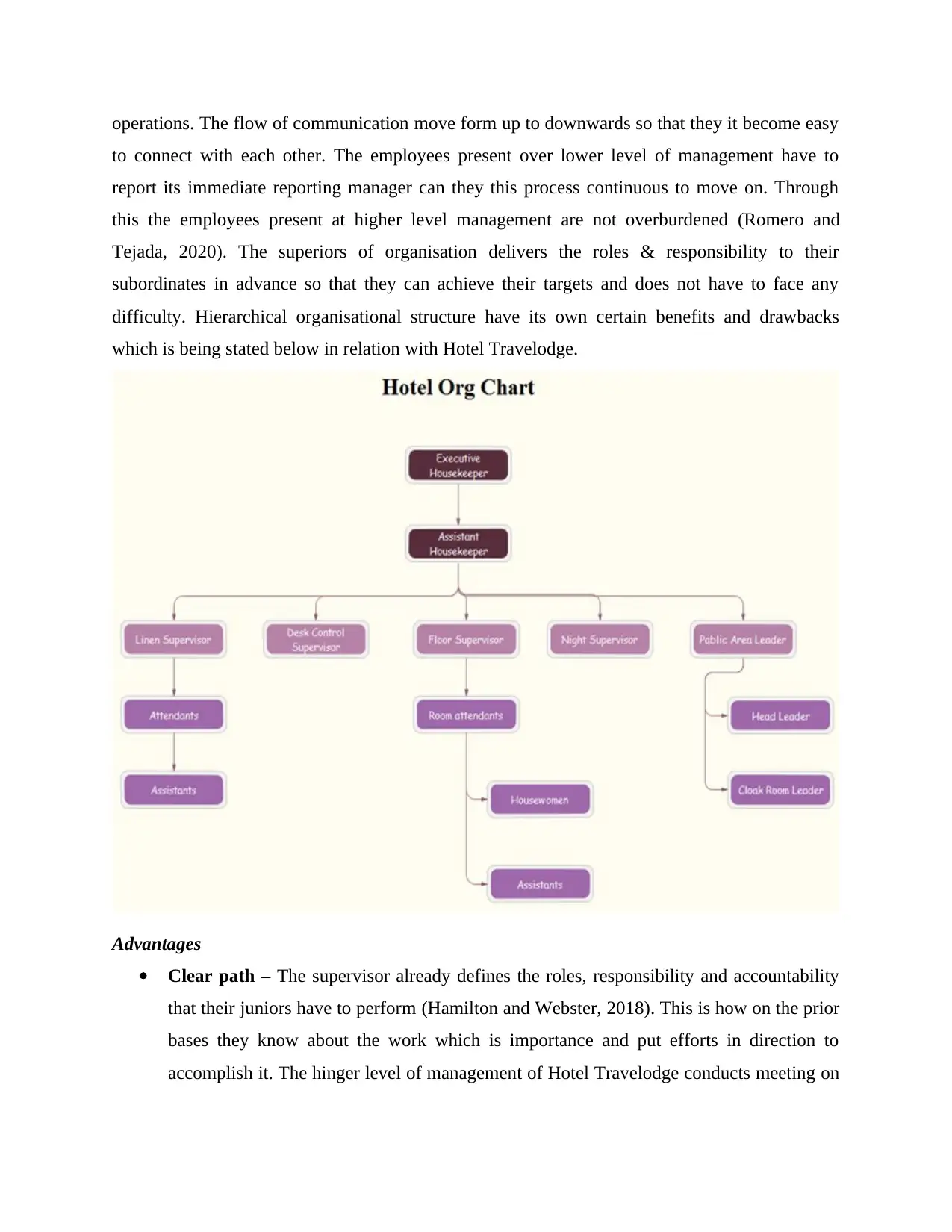
operations. The flow of communication move form up to downwards so that they it become easy
to connect with each other. The employees present over lower level of management have to
report its immediate reporting manager can they this process continuous to move on. Through
this the employees present at higher level management are not overburdened (Romero and
Tejada, 2020). The superiors of organisation delivers the roles & responsibility to their
subordinates in advance so that they can achieve their targets and does not have to face any
difficulty. Hierarchical organisational structure have its own certain benefits and drawbacks
which is being stated below in relation with Hotel Travelodge.
Advantages
Clear path – The supervisor already defines the roles, responsibility and accountability
that their juniors have to perform (Hamilton and Webster, 2018). This is how on the prior
bases they know about the work which is importance and put efforts in direction to
accomplish it. The hinger level of management of Hotel Travelodge conducts meeting on
to connect with each other. The employees present over lower level of management have to
report its immediate reporting manager can they this process continuous to move on. Through
this the employees present at higher level management are not overburdened (Romero and
Tejada, 2020). The superiors of organisation delivers the roles & responsibility to their
subordinates in advance so that they can achieve their targets and does not have to face any
difficulty. Hierarchical organisational structure have its own certain benefits and drawbacks
which is being stated below in relation with Hotel Travelodge.
Advantages
Clear path – The supervisor already defines the roles, responsibility and accountability
that their juniors have to perform (Hamilton and Webster, 2018). This is how on the prior
bases they know about the work which is importance and put efforts in direction to
accomplish it. The hinger level of management of Hotel Travelodge conducts meeting on
Paraphrase This Document
Need a fresh take? Get an instant paraphrase of this document with our AI Paraphraser
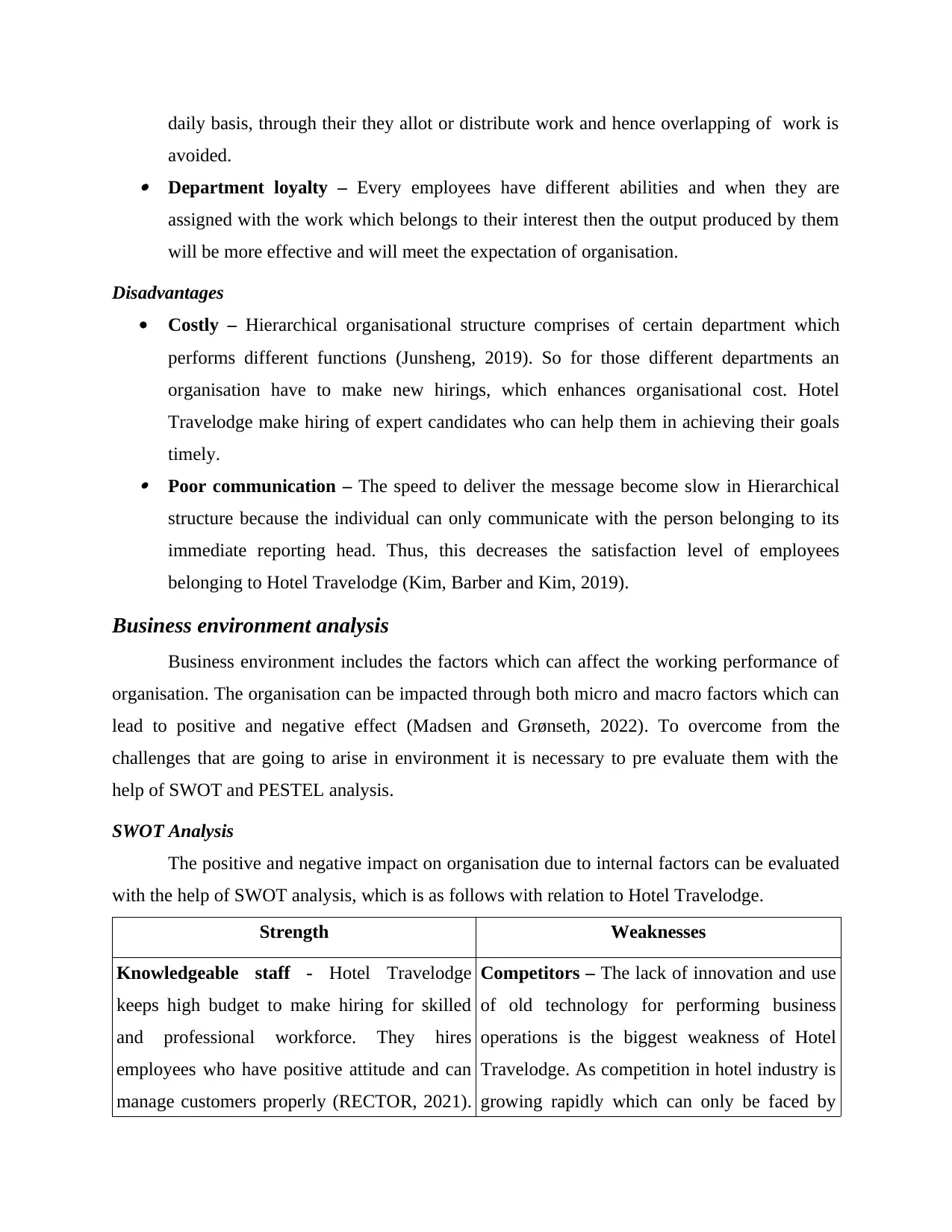
daily basis, through their they allot or distribute work and hence overlapping of work is
avoided. Department loyalty – Every employees have different abilities and when they are
assigned with the work which belongs to their interest then the output produced by them
will be more effective and will meet the expectation of organisation.
Disadvantages
Costly – Hierarchical organisational structure comprises of certain department which
performs different functions (Junsheng, 2019). So for those different departments an
organisation have to make new hirings, which enhances organisational cost. Hotel
Travelodge make hiring of expert candidates who can help them in achieving their goals
timely. Poor communication – The speed to deliver the message become slow in Hierarchical
structure because the individual can only communicate with the person belonging to its
immediate reporting head. Thus, this decreases the satisfaction level of employees
belonging to Hotel Travelodge (Kim, Barber and Kim, 2019).
Business environment analysis
Business environment includes the factors which can affect the working performance of
organisation. The organisation can be impacted through both micro and macro factors which can
lead to positive and negative effect (Madsen and Grønseth, 2022). To overcome from the
challenges that are going to arise in environment it is necessary to pre evaluate them with the
help of SWOT and PESTEL analysis.
SWOT Analysis
The positive and negative impact on organisation due to internal factors can be evaluated
with the help of SWOT analysis, which is as follows with relation to Hotel Travelodge.
Strength Weaknesses
Knowledgeable staff - Hotel Travelodge
keeps high budget to make hiring for skilled
and professional workforce. They hires
employees who have positive attitude and can
manage customers properly (RECTOR, 2021).
Competitors – The lack of innovation and use
of old technology for performing business
operations is the biggest weakness of Hotel
Travelodge. As competition in hotel industry is
growing rapidly which can only be faced by
avoided. Department loyalty – Every employees have different abilities and when they are
assigned with the work which belongs to their interest then the output produced by them
will be more effective and will meet the expectation of organisation.
Disadvantages
Costly – Hierarchical organisational structure comprises of certain department which
performs different functions (Junsheng, 2019). So for those different departments an
organisation have to make new hirings, which enhances organisational cost. Hotel
Travelodge make hiring of expert candidates who can help them in achieving their goals
timely. Poor communication – The speed to deliver the message become slow in Hierarchical
structure because the individual can only communicate with the person belonging to its
immediate reporting head. Thus, this decreases the satisfaction level of employees
belonging to Hotel Travelodge (Kim, Barber and Kim, 2019).
Business environment analysis
Business environment includes the factors which can affect the working performance of
organisation. The organisation can be impacted through both micro and macro factors which can
lead to positive and negative effect (Madsen and Grønseth, 2022). To overcome from the
challenges that are going to arise in environment it is necessary to pre evaluate them with the
help of SWOT and PESTEL analysis.
SWOT Analysis
The positive and negative impact on organisation due to internal factors can be evaluated
with the help of SWOT analysis, which is as follows with relation to Hotel Travelodge.
Strength Weaknesses
Knowledgeable staff - Hotel Travelodge
keeps high budget to make hiring for skilled
and professional workforce. They hires
employees who have positive attitude and can
manage customers properly (RECTOR, 2021).
Competitors – The lack of innovation and use
of old technology for performing business
operations is the biggest weakness of Hotel
Travelodge. As competition in hotel industry is
growing rapidly which can only be faced by
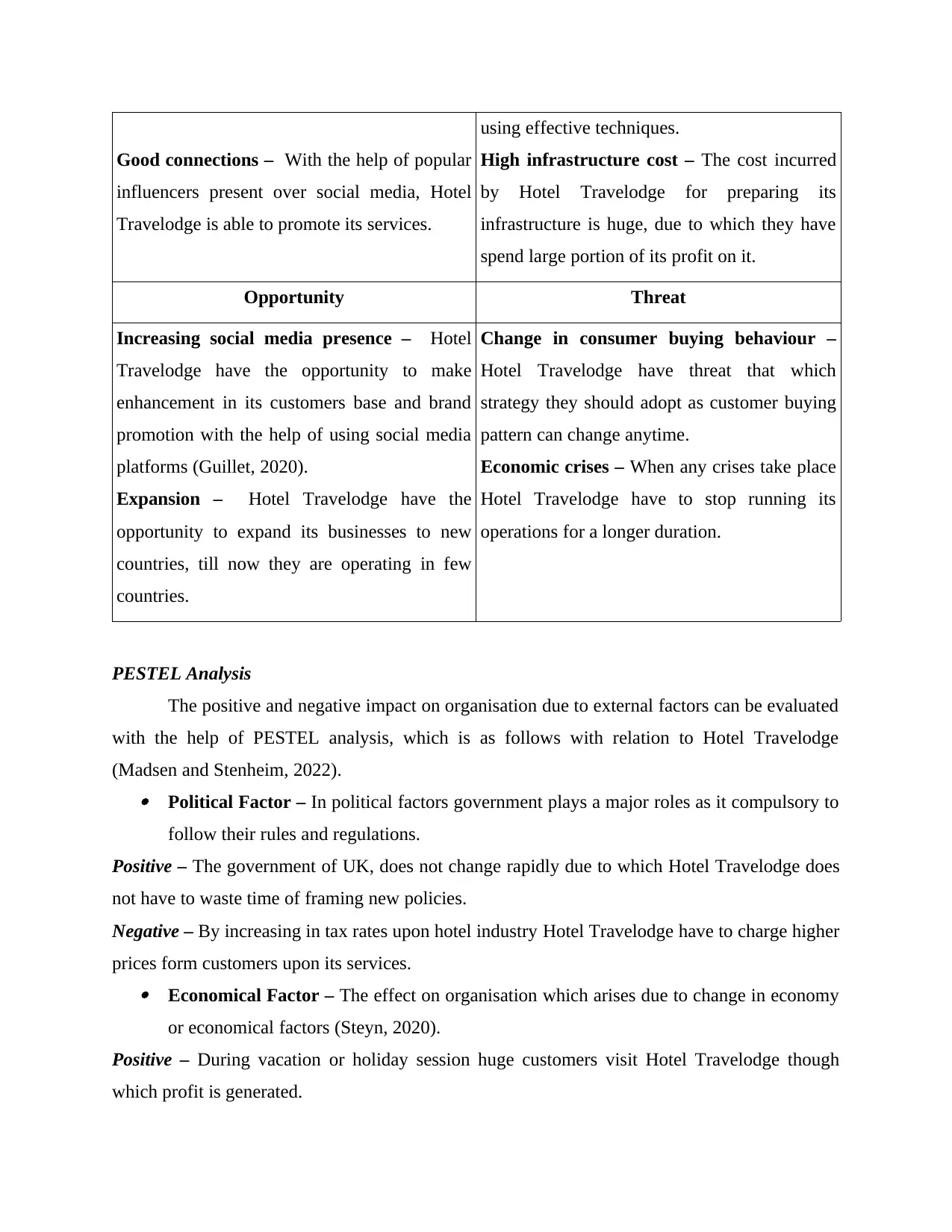
Good connections – With the help of popular
influencers present over social media, Hotel
Travelodge is able to promote its services.
using effective techniques.
High infrastructure cost – The cost incurred
by Hotel Travelodge for preparing its
infrastructure is huge, due to which they have
spend large portion of its profit on it.
Opportunity Threat
Increasing social media presence – Hotel
Travelodge have the opportunity to make
enhancement in its customers base and brand
promotion with the help of using social media
platforms (Guillet, 2020).
Expansion – Hotel Travelodge have the
opportunity to expand its businesses to new
countries, till now they are operating in few
countries.
Change in consumer buying behaviour –
Hotel Travelodge have threat that which
strategy they should adopt as customer buying
pattern can change anytime.
Economic crises – When any crises take place
Hotel Travelodge have to stop running its
operations for a longer duration.
PESTEL Analysis
The positive and negative impact on organisation due to external factors can be evaluated
with the help of PESTEL analysis, which is as follows with relation to Hotel Travelodge
(Madsen and Stenheim, 2022). Political Factor – In political factors government plays a major roles as it compulsory to
follow their rules and regulations.
Positive – The government of UK, does not change rapidly due to which Hotel Travelodge does
not have to waste time of framing new policies.
Negative – By increasing in tax rates upon hotel industry Hotel Travelodge have to charge higher
prices form customers upon its services. Economical Factor – The effect on organisation which arises due to change in economy
or economical factors (Steyn, 2020).
Positive – During vacation or holiday session huge customers visit Hotel Travelodge though
which profit is generated.
influencers present over social media, Hotel
Travelodge is able to promote its services.
using effective techniques.
High infrastructure cost – The cost incurred
by Hotel Travelodge for preparing its
infrastructure is huge, due to which they have
spend large portion of its profit on it.
Opportunity Threat
Increasing social media presence – Hotel
Travelodge have the opportunity to make
enhancement in its customers base and brand
promotion with the help of using social media
platforms (Guillet, 2020).
Expansion – Hotel Travelodge have the
opportunity to expand its businesses to new
countries, till now they are operating in few
countries.
Change in consumer buying behaviour –
Hotel Travelodge have threat that which
strategy they should adopt as customer buying
pattern can change anytime.
Economic crises – When any crises take place
Hotel Travelodge have to stop running its
operations for a longer duration.
PESTEL Analysis
The positive and negative impact on organisation due to external factors can be evaluated
with the help of PESTEL analysis, which is as follows with relation to Hotel Travelodge
(Madsen and Stenheim, 2022). Political Factor – In political factors government plays a major roles as it compulsory to
follow their rules and regulations.
Positive – The government of UK, does not change rapidly due to which Hotel Travelodge does
not have to waste time of framing new policies.
Negative – By increasing in tax rates upon hotel industry Hotel Travelodge have to charge higher
prices form customers upon its services. Economical Factor – The effect on organisation which arises due to change in economy
or economical factors (Steyn, 2020).
Positive – During vacation or holiday session huge customers visit Hotel Travelodge though
which profit is generated.
⊘ This is a preview!⊘
Do you want full access?
Subscribe today to unlock all pages.

Trusted by 1+ million students worldwide
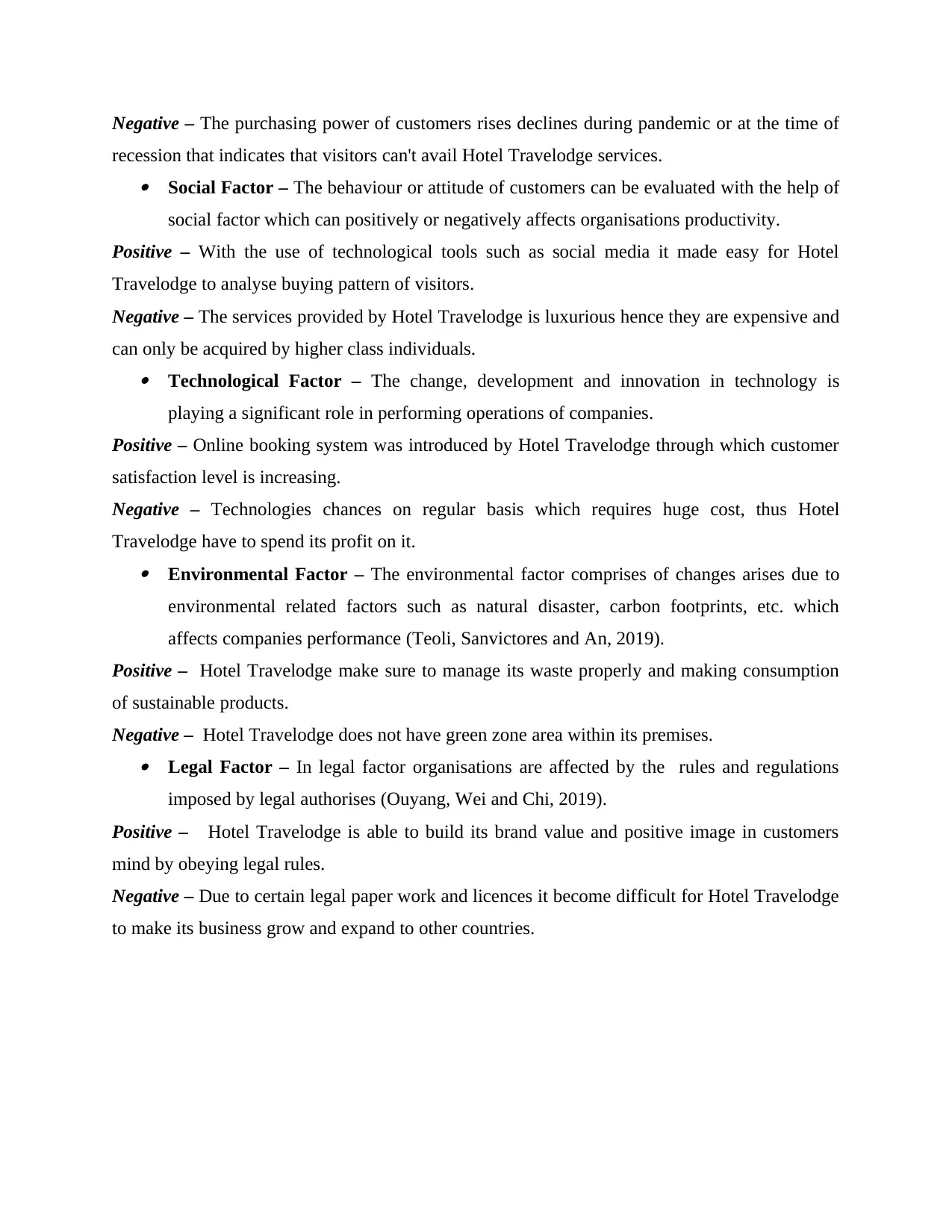
Negative – The purchasing power of customers rises declines during pandemic or at the time of
recession that indicates that visitors can't avail Hotel Travelodge services. Social Factor – The behaviour or attitude of customers can be evaluated with the help of
social factor which can positively or negatively affects organisations productivity.
Positive – With the use of technological tools such as social media it made easy for Hotel
Travelodge to analyse buying pattern of visitors.
Negative – The services provided by Hotel Travelodge is luxurious hence they are expensive and
can only be acquired by higher class individuals. Technological Factor – The change, development and innovation in technology is
playing a significant role in performing operations of companies.
Positive – Online booking system was introduced by Hotel Travelodge through which customer
satisfaction level is increasing.
Negative – Technologies chances on regular basis which requires huge cost, thus Hotel
Travelodge have to spend its profit on it. Environmental Factor – The environmental factor comprises of changes arises due to
environmental related factors such as natural disaster, carbon footprints, etc. which
affects companies performance (Teoli, Sanvictores and An, 2019).
Positive – Hotel Travelodge make sure to manage its waste properly and making consumption
of sustainable products.
Negative – Hotel Travelodge does not have green zone area within its premises. Legal Factor – In legal factor organisations are affected by the rules and regulations
imposed by legal authorises (Ouyang, Wei and Chi, 2019).
Positive – Hotel Travelodge is able to build its brand value and positive image in customers
mind by obeying legal rules.
Negative – Due to certain legal paper work and licences it become difficult for Hotel Travelodge
to make its business grow and expand to other countries.
recession that indicates that visitors can't avail Hotel Travelodge services. Social Factor – The behaviour or attitude of customers can be evaluated with the help of
social factor which can positively or negatively affects organisations productivity.
Positive – With the use of technological tools such as social media it made easy for Hotel
Travelodge to analyse buying pattern of visitors.
Negative – The services provided by Hotel Travelodge is luxurious hence they are expensive and
can only be acquired by higher class individuals. Technological Factor – The change, development and innovation in technology is
playing a significant role in performing operations of companies.
Positive – Online booking system was introduced by Hotel Travelodge through which customer
satisfaction level is increasing.
Negative – Technologies chances on regular basis which requires huge cost, thus Hotel
Travelodge have to spend its profit on it. Environmental Factor – The environmental factor comprises of changes arises due to
environmental related factors such as natural disaster, carbon footprints, etc. which
affects companies performance (Teoli, Sanvictores and An, 2019).
Positive – Hotel Travelodge make sure to manage its waste properly and making consumption
of sustainable products.
Negative – Hotel Travelodge does not have green zone area within its premises. Legal Factor – In legal factor organisations are affected by the rules and regulations
imposed by legal authorises (Ouyang, Wei and Chi, 2019).
Positive – Hotel Travelodge is able to build its brand value and positive image in customers
mind by obeying legal rules.
Negative – Due to certain legal paper work and licences it become difficult for Hotel Travelodge
to make its business grow and expand to other countries.
Paraphrase This Document
Need a fresh take? Get an instant paraphrase of this document with our AI Paraphraser
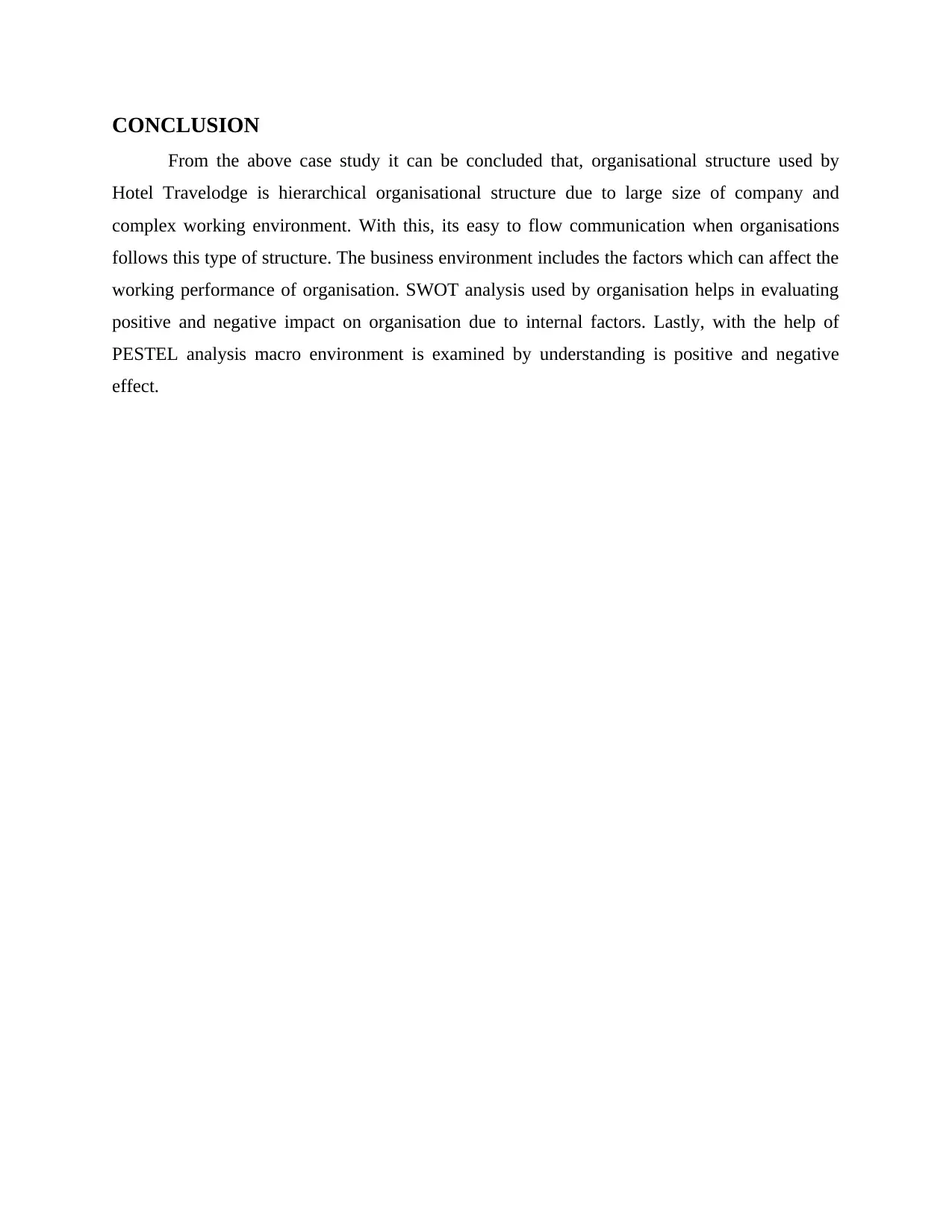
CONCLUSION
From the above case study it can be concluded that, organisational structure used by
Hotel Travelodge is hierarchical organisational structure due to large size of company and
complex working environment. With this, its easy to flow communication when organisations
follows this type of structure. The business environment includes the factors which can affect the
working performance of organisation. SWOT analysis used by organisation helps in evaluating
positive and negative impact on organisation due to internal factors. Lastly, with the help of
PESTEL analysis macro environment is examined by understanding is positive and negative
effect.
From the above case study it can be concluded that, organisational structure used by
Hotel Travelodge is hierarchical organisational structure due to large size of company and
complex working environment. With this, its easy to flow communication when organisations
follows this type of structure. The business environment includes the factors which can affect the
working performance of organisation. SWOT analysis used by organisation helps in evaluating
positive and negative impact on organisation due to internal factors. Lastly, with the help of
PESTEL analysis macro environment is examined by understanding is positive and negative
effect.
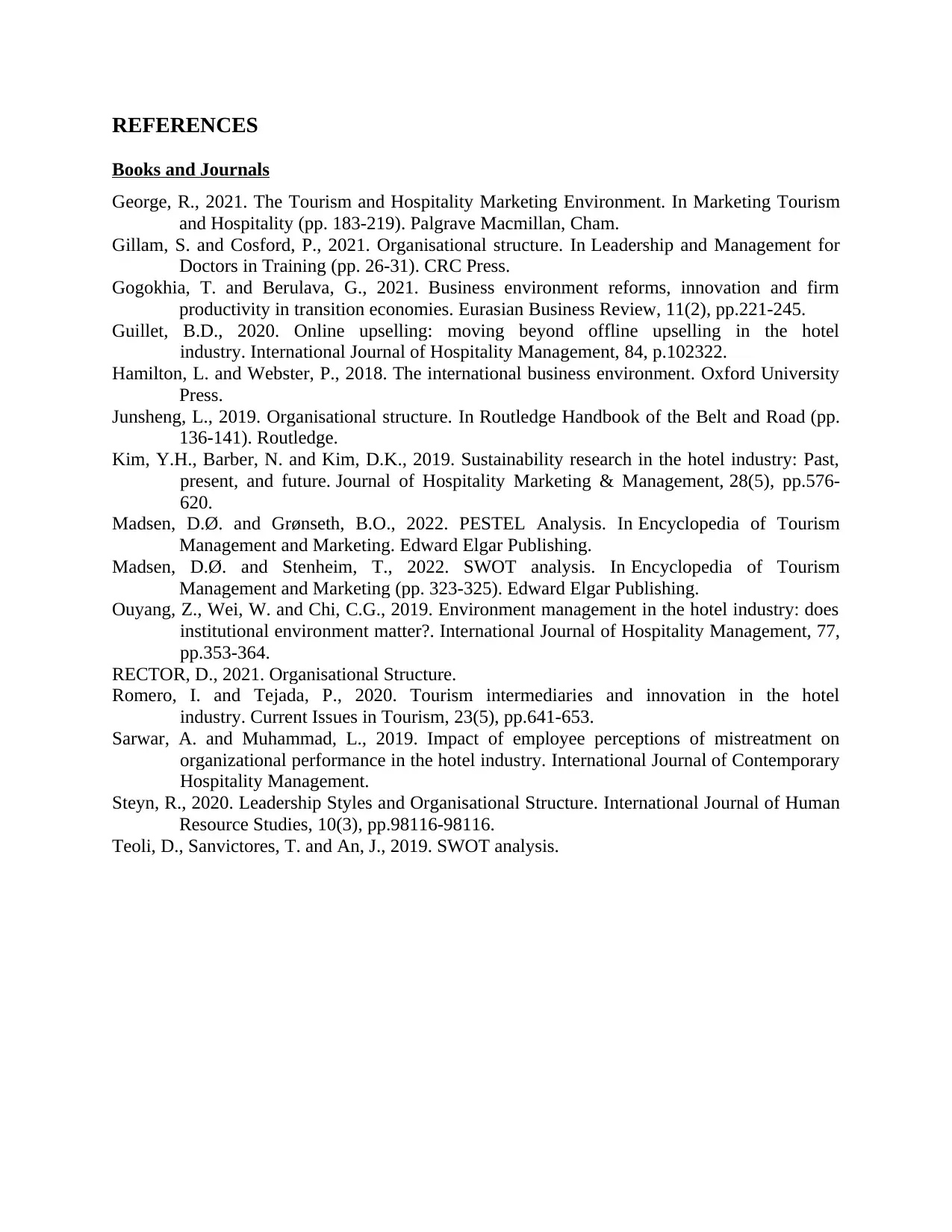
REFERENCES
Books and Journals
George, R., 2021. The Tourism and Hospitality Marketing Environment. In Marketing Tourism
and Hospitality (pp. 183-219). Palgrave Macmillan, Cham.
Gillam, S. and Cosford, P., 2021. Organisational structure. In Leadership and Management for
Doctors in Training (pp. 26-31). CRC Press.
Gogokhia, T. and Berulava, G., 2021. Business environment reforms, innovation and firm
productivity in transition economies. Eurasian Business Review, 11(2), pp.221-245.
Guillet, B.D., 2020. Online upselling: moving beyond offline upselling in the hotel
industry. International Journal of Hospitality Management, 84, p.102322.
Hamilton, L. and Webster, P., 2018. The international business environment. Oxford University
Press.
Junsheng, L., 2019. Organisational structure. In Routledge Handbook of the Belt and Road (pp.
136-141). Routledge.
Kim, Y.H., Barber, N. and Kim, D.K., 2019. Sustainability research in the hotel industry: Past,
present, and future. Journal of Hospitality Marketing & Management, 28(5), pp.576-
620.
Madsen, D.Ø. and Grønseth, B.O., 2022. PESTEL Analysis. In Encyclopedia of Tourism
Management and Marketing. Edward Elgar Publishing.
Madsen, D.Ø. and Stenheim, T., 2022. SWOT analysis. In Encyclopedia of Tourism
Management and Marketing (pp. 323-325). Edward Elgar Publishing.
Ouyang, Z., Wei, W. and Chi, C.G., 2019. Environment management in the hotel industry: does
institutional environment matter?. International Journal of Hospitality Management, 77,
pp.353-364.
RECTOR, D., 2021. Organisational Structure.
Romero, I. and Tejada, P., 2020. Tourism intermediaries and innovation in the hotel
industry. Current Issues in Tourism, 23(5), pp.641-653.
Sarwar, A. and Muhammad, L., 2019. Impact of employee perceptions of mistreatment on
organizational performance in the hotel industry. International Journal of Contemporary
Hospitality Management.
Steyn, R., 2020. Leadership Styles and Organisational Structure. International Journal of Human
Resource Studies, 10(3), pp.98116-98116.
Teoli, D., Sanvictores, T. and An, J., 2019. SWOT analysis.
Books and Journals
George, R., 2021. The Tourism and Hospitality Marketing Environment. In Marketing Tourism
and Hospitality (pp. 183-219). Palgrave Macmillan, Cham.
Gillam, S. and Cosford, P., 2021. Organisational structure. In Leadership and Management for
Doctors in Training (pp. 26-31). CRC Press.
Gogokhia, T. and Berulava, G., 2021. Business environment reforms, innovation and firm
productivity in transition economies. Eurasian Business Review, 11(2), pp.221-245.
Guillet, B.D., 2020. Online upselling: moving beyond offline upselling in the hotel
industry. International Journal of Hospitality Management, 84, p.102322.
Hamilton, L. and Webster, P., 2018. The international business environment. Oxford University
Press.
Junsheng, L., 2019. Organisational structure. In Routledge Handbook of the Belt and Road (pp.
136-141). Routledge.
Kim, Y.H., Barber, N. and Kim, D.K., 2019. Sustainability research in the hotel industry: Past,
present, and future. Journal of Hospitality Marketing & Management, 28(5), pp.576-
620.
Madsen, D.Ø. and Grønseth, B.O., 2022. PESTEL Analysis. In Encyclopedia of Tourism
Management and Marketing. Edward Elgar Publishing.
Madsen, D.Ø. and Stenheim, T., 2022. SWOT analysis. In Encyclopedia of Tourism
Management and Marketing (pp. 323-325). Edward Elgar Publishing.
Ouyang, Z., Wei, W. and Chi, C.G., 2019. Environment management in the hotel industry: does
institutional environment matter?. International Journal of Hospitality Management, 77,
pp.353-364.
RECTOR, D., 2021. Organisational Structure.
Romero, I. and Tejada, P., 2020. Tourism intermediaries and innovation in the hotel
industry. Current Issues in Tourism, 23(5), pp.641-653.
Sarwar, A. and Muhammad, L., 2019. Impact of employee perceptions of mistreatment on
organizational performance in the hotel industry. International Journal of Contemporary
Hospitality Management.
Steyn, R., 2020. Leadership Styles and Organisational Structure. International Journal of Human
Resource Studies, 10(3), pp.98116-98116.
Teoli, D., Sanvictores, T. and An, J., 2019. SWOT analysis.
⊘ This is a preview!⊘
Do you want full access?
Subscribe today to unlock all pages.

Trusted by 1+ million students worldwide
1 out of 9
Related Documents
Your All-in-One AI-Powered Toolkit for Academic Success.
+13062052269
info@desklib.com
Available 24*7 on WhatsApp / Email
![[object Object]](/_next/static/media/star-bottom.7253800d.svg)
Unlock your academic potential
Copyright © 2020–2025 A2Z Services. All Rights Reserved. Developed and managed by ZUCOL.



